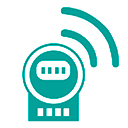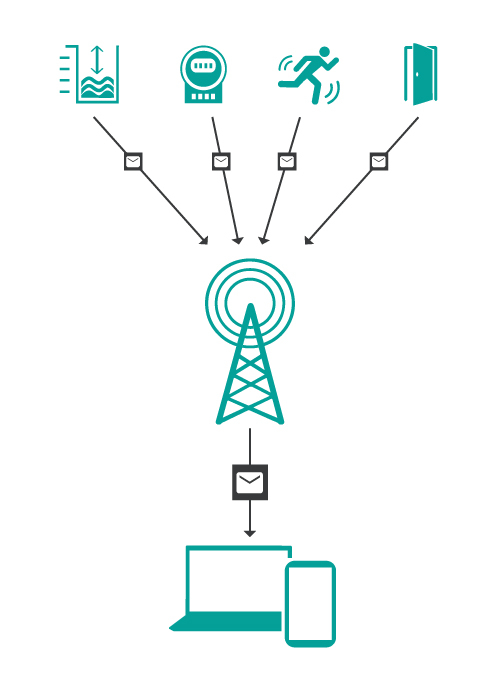What is NB-IoT?
NB-IoT (Narrowband Internet of Things) is a technology that was developed specifically for the Internet of Things and aims to connect devices over long distances with low energy consumption. It is a Low Power Wide Area Network (LPWAN) technology that builds on existing mobile networks. NB-IoT is particularly efficient in its use of spectrum and requires only a narrow bandwidth (200 kHz), making it ideal for transmitting small amounts of data over long periods of time.
Typical use cases for NB-IoT
Supply Chain Management
Logistical monitoring of goods and vehicles
Building digitalisation
Control and monitoring of HVAC systems and energy management

Submetering
Remote reading of electricity, gas and water meters

Smart City
Street lighting, traffic tracking and other remote monitoring systems

Industrial IoT (IIoT)
Monitoring systems and machines
Smart Agriculture
Monitoring soil moisture and weather conditions
NB-IoT compared to other IoT technologies
NB-IoT is particularly advantageous in scenarios in which devices only send small amounts of data sporadically and require a long battery life. NB-IoT is particularly advantageous in scenarios where devices only send small amounts of data sporadically and require a long battery life. As part of LPWAN (Low Power Wide Area Network) technologies, NB-IoT is known for its efficient use of network infrastructures, which sets it apart from other IoT technologies. It utilises existing mobile network infrastructure, particularly LTE (4G) networks, and is available in areas where the network operator has adapted this accordingly.

NB-IoT vs LoRaWAN - what's the difference?
Network coverage and availability: NB-IoT utilises existing LTE network infrastructures, meaning that it can be implemented relatively easily in areas with existing LTE coverage. NB-IoT is particularly beneficial where operators have already made the necessary upgrades and optimisations within their existing LTE networks to support this technology. This enables broad and deep network coverage, including urban and rural areas. Whereas LoRaWAN requires specialised gateways to build the network.
Data rates: NB-IoT offers higher data rates compared to LoRaWAN. Typically, data rates of around 200 kbps can be achieved. These higher data rates make NB-IoT suitable for applications that require more regular or denser data transmissions, such as smart energy metering or city management applications.
Penetration and range: High penetration in urban and indoor environments can be achieved with NB-IoT by utilising low LTE frequencies. LoRaWAN often encounters challenges in densely built-up environments.
Overall, NB-IoT is particularly attractive for applications that require strong network coverage and want to benefit from the existing mobile network infrastructure. The main advantage lies in the comprehensive support from major mobile network providers and the resulting extensive and reliable coverage, with minimal additional investment costs.
Is NB-IoT the right technology for you?
Feel free to contact us if you would like to discuss your specific application conditions and find out which IoT technology is best suited to your requirements.
Limitations of the NB-IoT technology
Availability and coverage: Despite the use of existing LTE networks, NB-IoT is not automatically available everywhere where LTE exists. Availability depends heavily on the specific investments and network infrastructure of the mobile network providers. In some regions, coverage may be inadequate, which limits the possible applications.
Network utilisation: As with all network technologies, the performance of NB-IoT can be affected by congestion, especially in urban areas where many devices may be connected at the same time. This can affect the reliability and performance of services.
Energy consumption at high transmission frequency: While NB-IoT is generally considered energy efficient, energy consumption can increase when the transmission frequency is increased or when stronger signal strength is required to overcome obstacles or greater distances.
Cost: Although NB-IoT is often touted as a cost-effective solution, actual costs can vary depending on network operator tariffs, the number of devices and the amount of data consumed.

Which NB-IoT hardware devices are available?
iot-shop has a large selection of hardware with NB-IoT technology and is constantly adding more. Take a look around and see for yourself!

